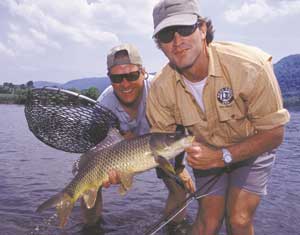
Some fish just can’t get any respect. Take the poor, unappreciated carp, please.Although considered a trash fish by most anglers in South Carolina and throughout North America, the carp is considered the king of sport fish in other parts of the world — particularly the United Kingdom and Europe.
The common carp grows to lunker size (the world angling record is 85 pounds), fights hard, and are wily and a real challenge to catch. These are not the dough ball-eating pond slugs at your local pay-to-fish mud hole. Wild carp are found throughout South Carolina in a variety of different waters, from small, golf course ponds to large rivers.
Still, carp get no love from Palmetto State anglers (not that they are really looking for that sort of love). They’re not listed as a gamefish in the S.C. freshwater fishing regulations, nor are there any state records regarding rod-and-reel catches.
I believe there are two primary reasons for this lack of respect:
• Most anglers consider carp a trash fish because they are bottom feeders. But most fish are bottom feeders — at least part of the time.
Carp are omnivorous, eating plant and animal matter. They’re not scavengers, however, preferring to hunt and capture their prey.
• Anglers believe carp are dumb and too easy to catch.
This widely-accepted rumor might be attributed to the fact most carp are caught by accident by anglers not targeting them.
“How challenging could they be if I catch them without even trying?” most anglers ask.
Carp are actually discrete feeders and are easily spooked when sought as quarry. Izaak Walton, the father of modern sport fishing, called carp the “River Fox” because “it is a very subtle fish and hard to be caught.”
Carp originally came to America from Asia and Europe during the late 19th century. In 1877 President Ulysses S. Grant created a Carp Commission that imported carp as a food fish because of the decline in other species at the time.
A pond full of carp was a good source of protein for a family going through hard times.
The highly-adaptable fish quickly spread throughout the country and is now found in a variety of water from coast to coast — warm waters, cool waters, lakes, ponds and rivers.
The bad press for the carp began when it was believed — wrongly and unfairly — that carp competed with and drove down the populations of other native fish. It was all downhill from there for Cyprinus Carpio.
But that might be changing.
In the button-down world of fly fishing, carp are quickly becoming one of the most sought-after fish species. Legendary angler and editor-at-large at Flyfisherman magazine, Dave Whitlock believes the carp is America’s smartest and most challenging gamefish and considers it one of his favorite species to catch on a fly.
Trout guides, during their days off, stalk 40-pound “golden ghosts” and passionately discuss the latest, hottest carp patterns. Carps aggressively take a dry fly or other small surface poppers or lures. They also will ambush a crankbait, spinner or a variety of baitfish imitations.
Carp usually can be found in shallow water and sight fishing for 20- and 30-pound fish with light-tackle or fly-fishing equipment can be the ultimate angling rush.
When hooked, their reactions are highly unpredictable. They can explode like a torpedo with bonefish-like speed while a reel begs for mercy, or they can sulk near the bottom — using their considerable body weight against an angler’s rod. Either way, they’re no slouches in the fighting department.
So carp fishing may not be socially respectable. An angler may be disowned by his more-refined fishing friends for a while.
But the bottom line is that catching carp is fun, and that’s what fishing should be all about.
Once anglers let go of their hang ups and prejudices about carp and see them what they really are, carp might well be the one of the premier gamefishes of the 21st century.
Carpe diem (seize the carp).


